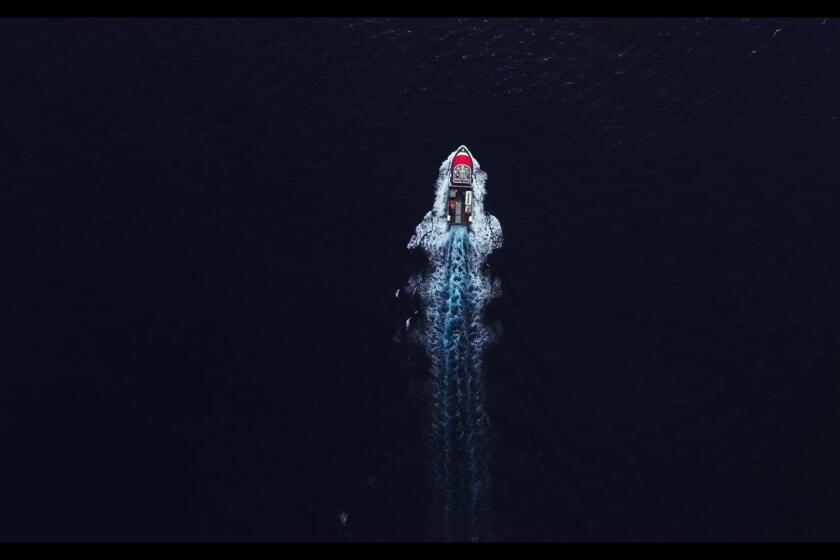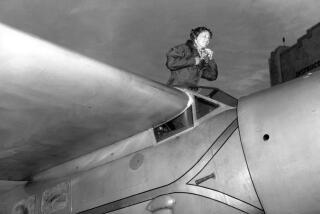He thought he’d found Amelia Earhart’s plane. It was a pile of rocks

- Share via
When Tony Romeo and his crew saw the bright yellow shape resembling a cross on their computer, they thought they had answered one of the great mysteries of the 20th century.
Surely, the grainy image had to be Amelia Earhart’s long-lost plane, 16,000 feet beneath the surface of the Pacific Ocean.
But after a second expedition to the site, Romeo announced this week that the discovery amounted to less than they had hoped.
It was a bunch of rocks.

When the crew of Deep Sea Vision first saw the grainy image on the left, they thought it was the airplane that Amelia Earhart had flown in 1937. This week, they released a higher resolution image that shows it to be a rock formation.
“I’m super disappointed,” Romeo told the Wall Street Journal.
The crew from Romeo’s company, Deep Sea Vision, had piloted their state-of-the-art submersible closer to the possible wreckage. What they hoped was the famed Lockheed Electra 10E Special, serial number 1055, turned out to be an “unfortunate” geologic formation, according to a company statement.
Romeo, who is still at sea and unavailable for comment, has been obsessed with Earhart since childhood, and finding the aviator’s aircraft would have been the culmination of a dream set into motion after the onset of the COVID-19 pandemic.
Since disappearing in 1937, Earhart has come to represent the power of such dreams. A talented aviator, daredevil and dashing superstar, she was attempting to circumnavigate the globe and encourage “other women toward greater independence of thought and action.”
Two months after setting out from California, she and her navigator, Fred Noonan, began the most challenging leg of their journey, to a small airfield — a critical fueling stop — on a flyspeck of an island halfway between Papua New Guinea and Hawaii.
They never made it.

Their sudden and unexplained disappearance has long vexed aviation experts and helped enshrine Earhart’s place in American culture. Some have argued that she survived a crash landing and have searched neighboring islands. Some say she plummeted into the sea.
While Romeo, a former real estate entrepreneur from Charleston, S.C., maintained some skepticism about the initial finding, he was excited that he and his team might have accomplished something that had eluded dozens of other expeditions.
“Why can’t six random guys solve aviation’s greatest riddle?” Romeo told The Times this year. “We’re no Robert Ballards. We’re no James Camerons. We’re just six guys who love the story and put together a business to solve it.”
Deep Sea Vision had first put to sea in September 2023 from Papua New Guinea, launching a $9-million Hugin 6000 submersible equipped with a Doppler, a magnetometer, an echo sounder and a side-scan sonar.
The Deep Sea Vision team was out to solve the greatest aviation mystery of all: the disappearance of Amelia Earhart on July 2, 1937, during her epic flight around the world.
For 100 days, they combed more than 2,500 square miles of ocean. They were heading home empty-handed when data from a previous day of exploration, which had originally been unreadable, was finally cleaned up.
Out of the grainy, sonar-generated black-and-yellow image of the ocean floor emerged a brighter yellow shape that resembled a plane. The image was marred by interference, but Romeo thought he could make out twin vertical stabilizers on the tail. In media interviews, he never revealed the location of the find.
Once home, Romeo began raising money for a second trip to confirm that the cross-shaped object was indeed Earhart’s plane. Three months at sea had cost the company about $15,000 a day, he told The Times.
To help defray the expense, he invited selected media outlets, including The Times, to bid on exclusive use of the photos, if the find was confirmed. The Times declined the offer.
Romeo planned to raise the fuselage and eventually install it in the Smithsonian.

As promising as Deep Sea Vision’s claim was — garnering, according to Romeo, the attention of billions of people worldwide — some experts were never convinced.
An assessment at the time from Dave Jourdan, president and founder of Nauticos, which has mounted four expeditions to find Earhart’s plane, proved correct: “It could be an aircraft. It could be a pile of rocks that looks like an aircraft.”
Deep Sea Vision is now branching out from its original mission, working with “foreign governments, international organizations and corporations” interested in its underwater technology.
But Romeo isn’t giving up.
For another month, he and his crew will continue their search, covering more than 1,500 square nautical miles of uncharted ocean. Somewhere out there, Romeo is confident, lies the answer to Earhart’s disappearance.
More to Read
Sign up for Essential California
The most important California stories and recommendations in your inbox every morning.
You may occasionally receive promotional content from the Los Angeles Times.











